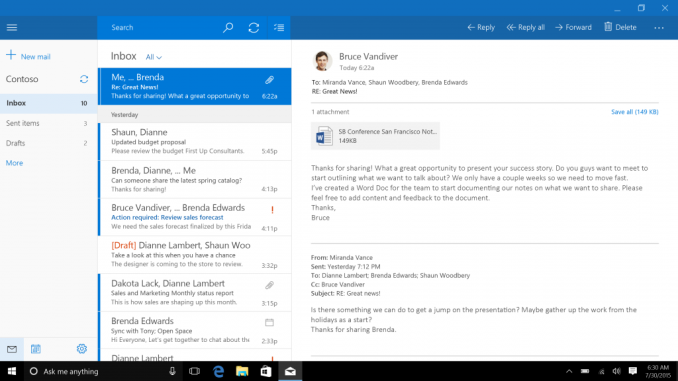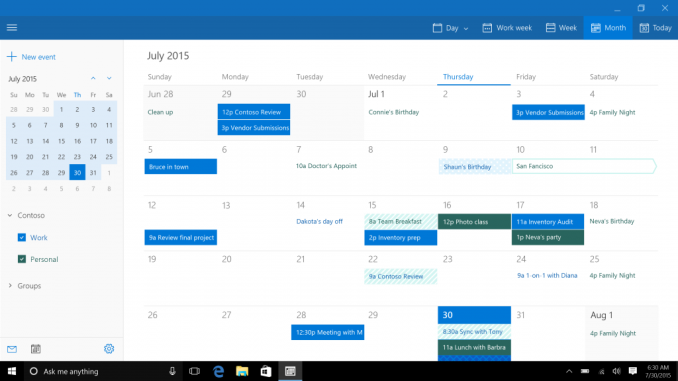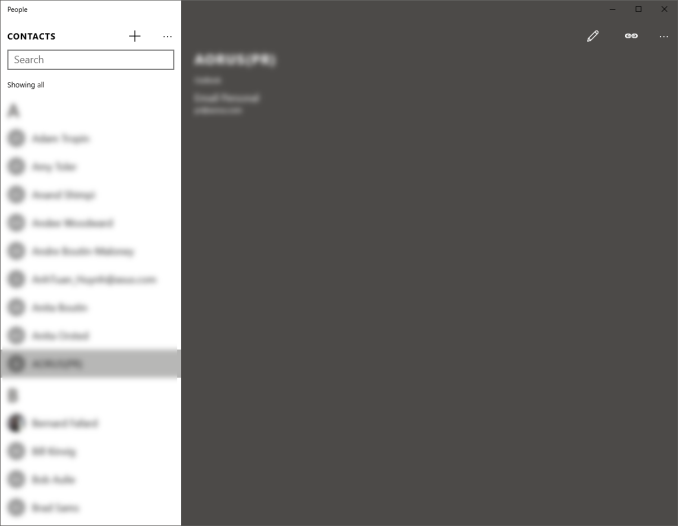The Windows 10 Review: The Old & New Face of Windows
by Brett Howse on August 25, 2015 8:00 AM EST- Posted in
- Operating Systems
- Microsoft
- Windows 10
Mail, Calendar, and People
In the days of Windows 7, the basic functionality of email, calendar, and contacts, were split out of Windows 7 and moved into Windows Live Essentials. The idea behind this was that by moving them out of Windows, they would be able to be updated more often. I’m not sure that ever really happened though.
Windows 8 brought new touch-first versions of all of these apps, and they could be tied to your Microsoft Account to allow mail, contacts, and calendar, to easily sync among devices. But the Windows 8 versions of the apps were very sparsely laid out, and although they worked on touch, the design and functionality was lacking. This improved, at least slightly, with Windows 8.1, but for Windows 10 Microsoft has once again overhauled these products to follow the Windows 10 design language, and all of them are Universal Windows Apps which means that they are not only updated through the store, they are also scalable and can work on small phones, all the way up to large desktop devices, with different layouts depending on what device type they are being used on.
Email is a staple of our lives now, and a quality experience is something that we have come to expect and rely on. In December 2014, Microsoft acquired Acompli, which was one of the highest ranked email clients on iOS. This acquisition was about more than just iPhone and Android though, and the design of their email client has certainly permeated into the Windows 10 mail client as well.
The basic layout is a list of accounts and folders on the left, with the current folder list in the center, and a reading pane on the right. When no email is selected, the right pane displays an image, which by default is an image of clouds. Like the mobile apps, the Windows 10 app now supports swiping the messages in the inbox to delete or flag the messages, which is a great way to deal with the mail when using touch. Swiping left deletes the message, and swiping right marks it as flagged. You can change what the swipes do in options as well.
As a basic mail client, it works fine, but there are some issues with it out of the box which may or may not get fixed over time. First, and I believe this is important for consistency in the operating system, the default action of swiping left to delete a message is the exact opposite of Action Center, where you have to swipe to the right to remove a notification. It’s a small thing, but I’ve gotten used to dismissing notifications, so you would think it would be the same action in email but it is not.
I also don’t love the giant image on the right. When you open Mail, the entire right pane has a picture of blue clouds. You can set it to whatever image you would like, but when I open the mail client, I would prefer an option to be able to display whatever message is the latest. This doesn’t need to be by default of course.
There is also no option to disable conversation view, and while many people like that, many people also prefer to have their email listed chronologically so they can find it. Update 2015-09-03: An update as of today lets you disable conversation view in settings.
One of the biggest issues for me is that there is no way to send as anything but the default email address. In Outlook.com, I can send and receive as a number of accounts, but in the Windows 10 mail app, there is no way to choose which email address to send from.
Considering Microsoft just bought Acompli in December 2014, perhaps some slack should be given considering how much works well out of the box, but as it stands now, the Mail client is just ok for light work, and is pretty easily surpassed in functionality by even Microsoft’s web based mail.
Taking a look at the Calendar app, once again we see a big departure from the Windows 8 version, which is a good thing. The new app is a very clean look, and it is easy to add new events, sort what events are seen, and which calendars are displayed. You can choose whether to start the week on Sunday or Monday, what your hours of work are, and colors for the various calendars displayed. You can choose a view of a day, week, work week, or month. It does what you would expect a calendar to do, and the layout once again can optimize itself to how much display it has to work with. However, like Mail, it’s not quite done yet. There is no way (that I have seen anyway) to create a new calendar, or share calendars from within the app. To do this, even if you are using an outlook.com calendar, you have to go to the web interface.
Moving to the People app, we see yet another redesign to a look that is a lot cleaner and easier to use. The contacts themselves have changed from square pictures to circles, consistent with the rest of Windows 10’s profile pictures which are now circles as well. It is pretty easy to add, edit, or remove a contact, and you can action the email or mapping to launch the respective apps for that.
I feel like a broken record again, but the People app is also lacking things that were available in Windows 8.1. The app no longer pulls contact info or pictures from social networks, and you can’t action the phone numbers in a contact to launch Skype. However if you go into settings, social network integration looks like it is coming, but for the moment there are no results when you try to add one. In another inconsistency, the options for People are not found behind the gear icon like in Calendar and Mail, but behind an ellipse and settings.
You can open Calendar from Mail, and Mail from Calendar, but People has to be opened on its own. Typing in a person’s name for a new mail brings results from People, but there is no way to choose the recipient from People without starting type their name. All of it feels a bit disjointed at the moment.
The good news is that all three apps support multiple accounts from multiple sources, including Outlook.com, Exchange, Office 365, Google, iCloud, or even by manually setting them up with POP or IMAP. There is support for setting how your mail syncs, how far back to sync messages, and what notifications to display.
As a set, these three apps are likely fine for a lot of use cases, but they are clearly works in progress at the moment. Luckily all of these apps are Windows Store apps, and can be updated over time easily through that mechanism. Let’s hope they get some updates soon though.













293 Comments
View All Comments
Brett Howse - Friday, August 28, 2015 - link
If you are talking about Family Safety, it needs to explicitly be turned on, and it's been there since Vista. And, when you log in, there is a prompt every time letting you know the account is monitored with family safety. This is not new to Windows 10.jameskatt - Friday, August 28, 2015 - link
Privacy is a concern. After all, Microsoft IS STORING your data on its servers. And it can EXTRACT THAT DATA in order to send you reports about activities on your computers.So OBVIOUSLY, someone else can gain access to that data - for example the GOVERNMENT, THE NSA, THE FBI, THE POLICE, HACKERS, LAWYERS, etc. Anyone who wants data on you can obtain it straight from Microsoft. Microsoft has built the ultimate tracking system into Windows 10.
Notmyusualid - Friday, August 28, 2015 - link
I completely agree.name99 - Saturday, August 29, 2015 - link
Shorter Brett (and a million other MS fans):"a thousand bugs, limitations, restrictions, and not yet implemented features that, on an Apple OS would be considered utterly unacceptable, are just fine in this context because it's MS'.
I'm glad that MS has (finally) stepped up its game to some extent --- for example I hope the WiFi Sense stuff puts pressure on Apple to get its act together in this area --- but, come on, you know I am right about. Every damn page contains an apology for some problem or other with the OS. MS released this WAYYYY too soon; and unlike Apple they don't even have the excuse that "oh, we had to do it to hit our hardware dates" (an excuse that is wearing very thin with Apple, and if they can't release iOS 9 and OSX 10.11 essentially bug-free, I think it's time to decouple the OS releases from the new phone hardware, starting next year).
Vinchent - Saturday, August 29, 2015 - link
I think that the key words for Windows 10 are redundancy and inconsistency. Ok, I've installed the new OS over W8 a couple of weeks ago, so it's a bit early to judge any OS whatsover but ""A good beginning makes a good ending".Dear Microsoft, we don't want apps. Do you get it? No apps on desktop machines. By now, 99% of desktop users use their PC only to work or play.
We don't e won't use Cortana, we are faster by using mouse+keyboard.
We will never open an app, we just use the browser for almost anything.
We just use Edge to download Chrome (or whatever). Yeah it's good, but it's too late now.
We are not happy with having 2 Control panels. 99% of the time, if we want to set things up, we will use the classic tools, which are way more powerful.
My dream? When I install the new W10 I'd like to have just 2 options: Baby mode (with apps, cortana, edge) and classic mode (no apps, no redundancy, no garbage).
Ignatzz - Saturday, August 29, 2015 - link
So how come everybody I know who's upgraded thinks Windows 10 stinks? As for me, it just won't upgrade - it fails every time.But there's also this:
"Windows 7 is used by hundreds of millions of people, but its touch support is practically zero."
Maybe that means there's still a large market for no touch screen. Speaking for myself, I see why you'd want touch screen on a computer that you carry with you, but I have zero interest in it for a home computer. The keyboard simply works better, and getting rid of it offers no real advantage.
Ignatzz - Saturday, August 29, 2015 - link
I've often said that Windows does a good job with every OTHER operation system. XP was good, Vista was lousy. Windows 7 was good. Windows 8 was lousy.By going from 8 right to 10, they seem to have skipped the good one.
jabber - Saturday, August 29, 2015 - link
Oh anyone who uses the term 'M$' loses all credibility instantly.Be a little more original please. Otherwise you look like 'new kid on the internet'.
cjcox - Monday, August 31, 2015 - link
Article was a bit too "pro Microsoft" without pointing out all of the losses of feature / functionality, especially vs. Windows 7. I know we had to put the Zune software onto our Windows 10 because of all the features lacking in Groove. And the Zune software isn't supported anymore, but still the only full featured product that Microsoft made. Oh well. Microsoft continues to take many steps backwards... hard to figure out what their end goal is. So... Microsoft 10 adds features you likely don't care about, didn't ask for and removes many things you used to use. That's a better summary review.cjs150 - Tuesday, September 1, 2015 - link
cjcox: Having used w10 for several weeks now, I completely agree about Groove - I went back to Windows Media Player.There are good points and bad points in w10 (multiple desktops good, new start menu bad), but it feels slightly faster than w8.1 on my NUC